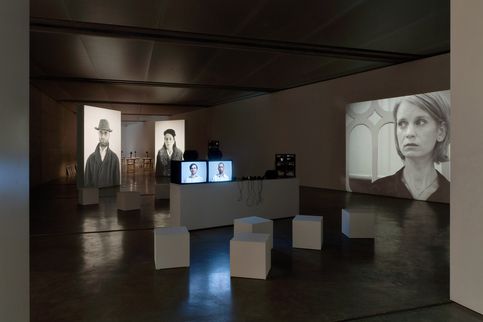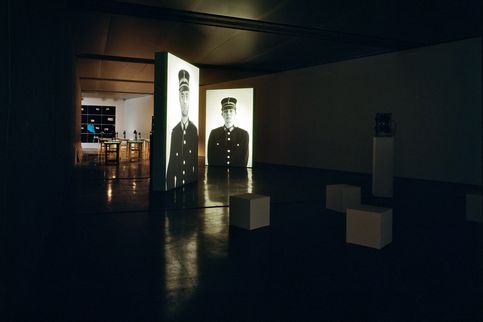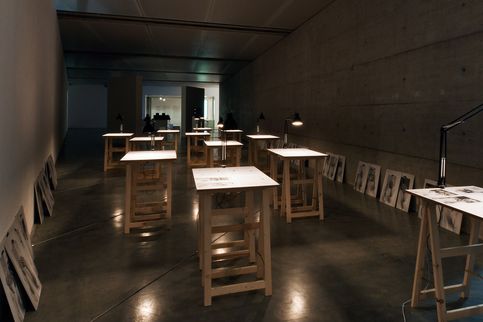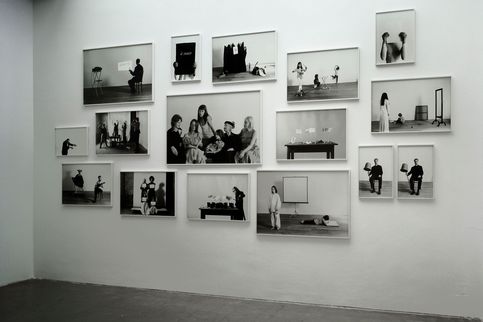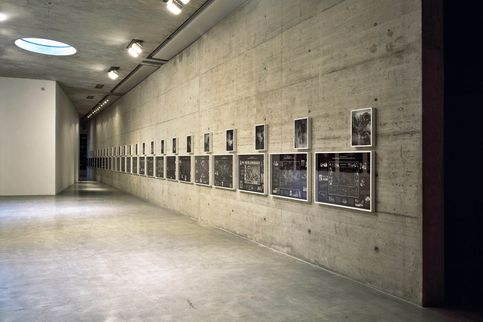Ana Torfs
Album/Tracks B
Curator: Sabine Folie
Assistant Curator: Georgia Holz
An exhibition organized by K21 Kunstsammlung Nordrhein-Westfalen, Düsseldorf and Generali Foundation, Vienna
ALBUM/TRACKS B may refer to a photo album which, empty at first, tells a "(hi)story" only once it is filled with pictures, a story to look at, read, and interpret from ever new points of view. The work of Ana Torfs (born in 1963, lives in Brussels) could also be understood as a tribute to certain personalities and events from history, literature, and film whose tracks— hence the title—and traces the artist pursues and endows with new life. Thus, Torfs frequently explores literary and historical material such as the Inquisition’s files on Joan of Arc (Du mentir-faux, 2000), the court records from the trial for the murder of Rosa Luxemburg and Karl Liebknecht (Anatomy, 2006), or Ludwig van Beethoven’s conversation books (Zyklus von Kleinigkeiten, 1998). The media that serve to convey these subjects are multifaceted reproductive techniques, ranging from film, video, slide installation, and photographic series to xerography and silkscreen.
In 1998, after her hitherto only feature film Zyklus von Kleinigkeiten, the artist turned to and developed the more contemplative and focused form of slide installations besides her photographic work. The slide installation ideally lends itself to the emphasis and contemplation of a figure or historical event. It allows avoiding the static quality of photography while retaining its accuracy and benefitting from the monumentality of large film images and the use of sound. With bravura and precision, Torfs arranges image—mostly large close-ups of faces and places, restrained and hence paradoxically suggestive—and sound—sparse yet impressive text and music—into visually powerful, psychologically impregnated tableaux.
ALBUM/TRACKS A and B offered the first comprehensive survey of Torfs’ work, with the exhibitions at K21 in Düsseldorf and the Generali Foundation in Vienna complementing each other. While both venues presented a selection of earlier works, though with a slightly different emphasis, the artist’s new photographic series Family Plot #1 and #2 as well as Legend were shown in Vienna for the first time. Family Plot centers on the subject of Carl Linnaeus’ botanic nomenclature and explores the ramifications of the history of botany and colonization. Torfs understands Linnaeus’ “elitist” system of naming the globe’s flora as an instance of “linguistic imperialism,” which she traces by means of found portraits, historical maps, and other archival material.
Legend links the meanings of the word "legend" as "myth" and "caption" with mythological narratives, historical facts of colonization, and contemporary refugee issues on the Canary Island of La Gomera. The then-new slide installation Displacement was on view for the first time at both venues.The Swedish island of Gotland, which Ana Torfs first came to for a residency in 2007, inspired the artist to embark on a photographic remake of Roberto Rossellini’s Viaggio in Italia from 1954. Black-and-white photographs of the barren island scenery, which still reveals clear traces of its military use during World War II, as well as pictures of charged places of memory are confronted with the protagonists’ portraits; the dialogues of a couple becoming estranged during a journey were to be heard via headphones. Torfs interweaves the spoken word and the static photographic image to unfold an imaginary space that conveys internal and external experience, projection and introspection.
The relationship and interplay of text and image constitute a central aspect of Ana Torfs’ oeuvre, which is particularly evident in the two-part installation Elective Affinities/The Truth of Masks & Tables of Affinities (2002). The artist’s notes, working and archival materials are spread out on 14 tables, literary fragments and motifs of thought, associatively arranged. The two slide projections show portraits of a man and a woman presenting themselves in changing costumes, but always the same postures. The seemingly endless masquerade of the two models in the slide projections—they never show their “true faces”—can be read ad libitum in connection with the texts, but it can also be regarded as a playful interrogation of concepts such as truth and identity. Yet in light of the, often radical, “resistance” on the part of individuals to intolerance, alienation, and extremism—a central issue in the texts and images the artist has selected—these questions acquire new weight.
Some of Ana Torfs’ works are also accompanied by publications displaying the careful attention to graphics and content that is found in her works. The books serve as an extension and commentary, a kind of exegesis by the artist herself, and yet stand for themselves. In Torfs’ publications, the text is heightened, as are language and voice in her installations, whether spoken or presented in the form of inserts. This brings on a theatrical mode which further deepens the reflexive dimension of the subjects represented and is owed to the use of an alienation effect as described by Bertolt Brecht: regarding theater as a theater of filtered and essentialized emotions and senses which are understood as social gestures.
